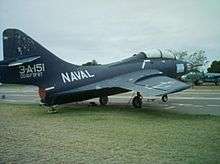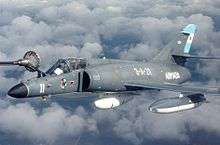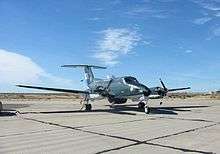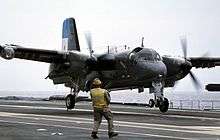Argentine Naval Aviation
| Comando de Aviación Naval Argentina Argentine Naval Aviation | |
|---|---|
| Active | 1916 – present |
| Country |
|
| Branch | Argentine Navy |
| Type | Naval aviation |
| Size | 47 aircraft |
| Part of |
Navy Ministry of Defense |
| Engagements | Gulf War |
| Commanders | |
| Commander-in-Chief | President |
| Chief of Staff of the Navy | Admiral |
| Chief of COAN | Rear Admiral |
| Insignia | |
| Roundel |
 |
| Former roundel |
.svg.png) |
The Argentine Naval Aviation (Spanish: Comando de Aviación Naval Argentina, COAN) is the naval aviation branch of the Argentine Navy and one of its four operational commands. Argentina, along with Brazil is one of two South American countries to have operated two aircraft carriers
The acronym CANA is often used in English language bibliographies,[1][2] but is not correct Spanish usage.
History
Formation and World Wars
COAN's origin trace back to 22 October 1912 when a navy officer, Lt Melchor Escola, graduated as a pilot. On 11 February 1916 the naval air station school Fuerte Barragan was created near La Plata and the anniversary of this is marked as Naval Aviation Day. In September 1917 three naval lieutenants were sent to the US Naval Air Station Pensacola from where were deployed to Europe to participate in World War I.
.jpg)
COAN was officially established on 17 October 1919 as the Naval Air Service. Over the following years, the COAN operated a variety of aircraft, mainly advanced trainer types imported from the USA including the North American AT-6, the Beechcraft AT-11 and the Consolidated PBY Catalina. Sikorsky S-51 helicopters joined the service shortly after the war in 1949.
Early combat operations
The COAN received a baptism by fire on 16 June 1955 when naval airplanes, painted with catholic crosses and blessed by priests, participated on the Bombing of Plaza de Mayo. One of the navy aircraft was shot down by an air force Gloster Meteor.
Navy pilots would see combat again during 1962 internal military fighting between factions known as Azules y colorados ( Blue and reds ), culminating in the 1963 Argentine Navy Revolt in which Navy F9F Panthers and F4U Corsairs bombed Argentine Army tanks in defense of the Navy base of Punta Indio.
A carrier navy


A great change came into effect when the Navy received its first aircraft carrier the ARA Independencia in 1959. At the time, her aircraft inventory included the F4U Corsair, SNJ-5Cs Texan and Grumman S2F-1 (S-2A) Trackers. The Navy also had F9F Panther and F9F Cougar jets but the carrier was not suitable for operating them although they were embarked during their delivery voyage from the United States to Argentina. The Cougar was the first jet to break the sound barrier in Argentina.[3] These jets would be involved in the general mobilization during the 1965 border dispute between Argentina and Chile but no combat occurred.
The naval training force received T-28 Trojans, T-34 Mentors and Aermacchi MB-326 jets which would be later reinforced with the most powerful variant MB-339.

In 1972 aircraft changed the word Naval to Armada painted on them pictorial
More aircraft entered service during the 1960s, including the C-47 Dakota[4] (which were extensively used in Antarctica including the first national landing on the South Pole made in 1962 by Captain Hermes Quijada who departed from Ellsworth Station[5]), Sikorsky S-55 helicopters and shore based aircraft P-2 Neptunes for maritime patrol duties.
In 1969 the Navy received her second carrier, the ARA 25 de Mayo from the Netherlands. On her voyage home, the British company Hawker Siddeley demonstrated its Harrier GR1 but the Argentines finally opted for the A-4Q Skyhawk instead. More helicopters were incorporated into the new carrier, the Alouette III and the SH-3 Sea King (the more advanced S-2E Tracker variant). Cargo planes Fokker F-28 and L-188 Electra modified for maritime patrol were also added.
The 1970s surface fleet modernization plan included the purchase of British destroyers with their complement of Westland Sea Lynx helicopters but their use would be affected by the upcoming events.
The military junta
In 1976, a Military Junta took power in Argentina and initiated a state-sponsored campaign of violence known as the Dirty War. Naval aviators were used to toss political prisoners (the "disappeared") into the River Plate, in the infamous Death flights.[6] In 1978, tension with Chile reached the highest point when the Argentine junta initiated Operation Soberanía. The war was avoided at the last minute by the intervention of pope John Paul II. By 1982, in order to maintain power by diverting public attention from the nation's poor economic performance and exploiting the long-standing feelings of the Argentines towards the Falkland Islands ( Spanish: Islas Malvinas ) the Junta ordered an invasion and triggered the ten-week-long Falklands War.
Falklands War
The naval aviation, suffering an arms embargo since 1978 by US President Jimmy Carter for human rights abuses,[n 1] was in the middle of the process of replacing their A-4Q Skyhawks with French-built Dassault-Breguet Super Étendards. Although only five aircraft were delivered by the time of the conflict, the service became famous worldwide when they used their AM39 Exocet anti-shipping missiles, also purchased from France, to sink the Royal Navy's HMS Sheffield and the support ship Atlantic Conveyor. The older A-4Qs also had a role destroying HMS Ardent.[7]
On the eve of war the Argentine carrier ARA Veinticinco de Mayo attempted to launch a wave of A-4Q Skyhawk jets against the Royal Navy Task Force after her S-2 Trackers detected the British fleet. However, what would have been the first battle between aircraft carriers since World War II did not occur, as poor winds prevented the heavily loaded jets from being launched[n 2] After the British nuclear-powered submarine HMS Conqueror sank the cruiser ARA General Belgrano, the carrier returned to port for safety and her Skyhawks began their attacks from mainland Argentina instead.
Navy's T-34s and MB-339s, along with Air Force's Pucarás, were the only combat aircraft based on the islands and an MB-339 was the first aircraft to engage the British landing force during the Battle of San Carlos.
During the war the last two SP-2H Neptunes were retired due to airframe attrition and replaced with two leased Brazilian EMB 111 Bandeirantes.[8]
Four naval aviators died in the war.[n 3] Fourteen aircraft were lost, to various causes.
Post war
_and_an_Argentinean_P-3_aircraft_patrol_the_northern_approach_to_the_Panama_Canal.jpg)
In 1983, Democracy was restored in Argentina and despite stricter military budgets, COAN was able to modernize with the lifting of arms embargoes. P-3 Orions and modified Beechcraft Super King Air were incorporated and Eurocopter Fennecs were bought as the new surface fleet embarked helicopter. New-built Agusta SH-3 Sea Kings for Antarctica arrived and UH-1H helicopters were assigned to the naval aviation to support the Argentine Marines. The navy also received Brazilian MB-326 Xavantes to replace their lost MB-339s.
The 1980s saw the last deployments of the ARA 25 de Mayo: the Dassault-Breguet Super Étendards and the Israeli upgraded S-2T Turbo Trackers performed qualifications on her until the ship's final retirement.Video
Argentina was the only South American country to send warships, including embarked Alouette IIIs and cargo planes to the 1991 Gulf War under UN mandate. In 1998, Argentina was granted Major Non-NATO ally status by United States President Bill Clinton.[9]
Present day
Since 2001, due to the lack of an aircraft carrier, pilot qualification tests take place on the Brazilian Navy carrier São PauloARAEX ops and/or touch-and-go landings on US Navy carriers when they are in transit within Argentine coastal waters for Gringo-Gaucho manoeuvres.Gringo-Gaucho Ops
On 2008 the United States transferred four Sea King helicopters to replace the two lost in the fire of the ARA Almirante Irizar icebreaker.[10] As of 2012 a lack of funds for training and maintenance has left the Navy in poor condition. In particular their aircraft are dependent on a steady supply of foreign-made spares, which has been reduced by currency controls and import restrictions - for example the Fokker F-28 transports are grounded because of spares getting stuck in customs.[11]
Argentina hoped to upgrade ten of its eleven remaining Super Étendard to the latest Super Étendard Modernisé (SEM) standard using equipment from aircraft retired by France. This is now in doubt since their retirement from French service has been put back to late 2016 and relations with France have cooled since the UK intervened to block the sale of Spanish Mirage F1's to the Argentine Air Force.[12]
Air bases




.jpg)
COAN has 5 main airbases ( Spanish: Base Aeronaval (BAN) ):
- Comandante Espora (BACE) at Bahía Blanca
- Almirante Zar (BAAZ) at Trelew
- Punta Indio (BAPI) near La Plata
- Almirante Quijada (BARD) at Río Grande, Tierra del Fuego.
- Naval air station Ezeiza (ETAE) at Ezeiza
Structure
Fuerza Aeronaval 1 (Naval Aviation Force 1)
The Fuerza Aeronaval 1 (FAE1) is based at Punta Indio Naval Air Base, near La Plata, Buenos Aires.
- Escuela de Aviación Naval (ESAN) (Naval Aviation School) : Beechraft T-34C-1Turbo Mentor
- 1ra Escuadrilla Aeronaval de Ataque (EA41) (1st Naval Attack Sqd) : In reserve, no aircraft assigned.
- Escuadrilla Aeronaval de Vigilancia Marítima (EA1V) (Maritime Surveillance Naval Sqd) : Beechcraft B200 Cormorán, locally converted for the maritime patrol role. Based at naval air Station Punta Indio (BAPI)
- 2da Escuadrilla Aeronaval de Sostén Logístico Móvil (EA52) (2nd naval Transport Sqd) : Based at naval air Station Ezeiza (ETAE) at Ezeiza International Airport in Buenos Aires, they use Fokker F28 Mk.3000C Fellowship for supporting all navy units.
Fuerza Aeronaval 2 (Naval Aviation Force 2)
The Fuerza Aeronaval 2 (FAE2) is based at navy airbase Comandante Espora, near Bahía Blanca and consists of all embarked aircraft.
- 2da Escuadrilla Aeronaval de Caza y Ataque (EA32) (2nd naval Fighter/Attack Sqd): Dassault-Breguet Super Étendard
- Escuadrilla Aeronaval Antisubmarina (EA2S) (Antisubmarine naval Sqd) : Grumman/IAI S-2T Turbo Tracker and Pilatus PC-6B2/H2 Turbo Porter
- 1ra Escuadrilla Aeronaval de Helicópteros (EAH1) (1st naval Helicopters Sqd) : Aérospatiale SA-316B Alouette III and Eurocopter AS-555SN Fennec
- 2da Escuadrilla Aeronaval de Helicópteros (EAH2) (2nd naval Helicopters Sqd) : Sikorsky S-61 D4 H-3 Sea King and Agusta AS-61 Sea King
- 3ra Escuadrilla Aeronaval de Helicópteros (EAH3) (3rd naval Helicopters Sqd) : Bell UH-1 Iroquois, assigned to the marines – transferred to the army on February 7, 2008.[13]
Fuerza Aeronaval 3 (Naval Aviation Force 3)
The Fuerza Aeronaval Numero 3 (FAE3) is based at Naval Airbase Almirante Zar, near Trelew to perform sea control and Search and rescue duties along the Argentine coast from the Uruguayan border to the Antarctic Peninsula.
- Escuadrilla Aeronaval de Exploración (EA6E) (Exploration naval Sqd) : Lockheed P-3B Orion
Naval aircraft inventory
| Aircraft | Origin | Type | Versions | In service[14] | Notes |
|---|---|---|---|---|---|
| Beechcraft Super King Air Cormoran | |
Maritime Patrol/Utility | Utility
MPA |
3
4 |
|
| FMA IA 63 Pampa | |
trainer aircraft | AT-63 Pampa III | 10 | |
| CASA C-212 Aviocar | Transport | 3 | |||
| Eurocopter AS 555 Fennec | |
Utility helicopter | AS 555 | 4 | |
| Fokker F28 Fellowship | |
Transport | F28-3000 | 3 | |
| Grumman S-2 Tracker | |
Maritime Patrol / Anti-submarine | S-2T Turbo Tracker | 4 | Originally S-2G, were converted to turbo-prop at IAI |
| Lockheed P-3 Orion | |
Maritime patrol | P-3C/B | 6 | |
| Pilatus PC-6 Turbo-Porter | |
Utility | PC-6B-H2 | 2 | |
| Sikorsky S-61 Sea King | |
Anti-submarine helicopter | Agusta ASH-3H
S-61D-4 |
10 |
In addition to the Naval aviation, a small air fleet is maintained by the Argentine Coast Guard.
For aircraft previously operated by the Argentine Navy, see List of aircraft of Argentine Naval Aviation.
See also
- Argentine Air Force
- Argentine Army Aviation
- Argentine air forces in the Falklands War
- List of aircraft of the Argentine Naval Aviation
Footnotes
- ↑ Backing the Humphrey-Kennedy amendment to the Foreign Assistance Act of 1976, the Carter administration placed an embargo on the sale of arms and spare parts to Argentina and on the training of its military personnel.
- ↑ "He hoped to be able to fly off six Skyhawks with a 240-mile combat radius and each armed with six 250kg bombs. He needed 40 knots of wind to be able to achieve this. At 22.00 the wind started to drop. He now calculated that it would take until 06.00 before he could be in a position to mount the attack. Two hours later at midnight the wind had dropped further....It was now estimated that an attack would not be possible.."- Freedman, Lawrence: Signals of war (1990) Faber and Faber. ISBN 0-571-14144-7
- ↑ Lieutenants Zubizarreta, Márquez (both A-4Q pilots) Benítez & Miguel (MB339s)
References
Portions based on a translation from Spanish Wikipedia.
Notes
- ↑ Air War in the Falklands 1982. Retrieved 24 December 2014.
- ↑ Google Books. Retrieved 24 December 2014.
- ↑ "AvNaval". Retrieved 24 December 2014.
- ↑ ARA DC-2/DC-3 history
- ↑ "Base Ellsworth". Retrieved 24 December 2014.
- ↑ Pagina 12 Aviones de la muerte
- ↑ "HMS Ardent Falklands War 1982". YouTube. Retrieved 24 December 2014.
- ↑ "PDF book: Historia de la Aviación Naval Argentina" (in Spanish). www.trackerenmalvinas.com.ar. Archived from the original on 2007-05-17. Retrieved 2010-01-21.
- ↑ "Overview of U.S. Policy Toward South America and the President's Upcoming Trip to the Region". Retrieved 24 December 2014.
- ↑ "NAVAIR delivers two more Sea King helicopters to Argentine Navy - News - Shephard". Retrieved 24 December 2014.
- ↑ "Argentine navy short on spares and resources for training and maintenance". MercoPress. 22 November 2012.
- ↑ Gonzalez, Diego (10 March 2014). "Argentine Super Etendard modernisation hits major snags". IHS Jane's Defence Weekly.
- ↑ Air Forces Monthly April 2008 issue, pp.18.
- ↑ World Air Forces 2016. Flightglobal International. 2015. p. 11.
Further reading
- Aviación Naval Argentina. Sebastian Sequeira, Carlos Cal y Cecilia Calatayud. ISBN 950-9064-02-5, SS&CC ediciones, Buenos Aires, 1984. (Spanish text)
- Arguindeguy, Pablo Eusebio (1980). Historia de la Aviación Naval Argentina, Tomo 1 (in Spanish). 1. Buenos Aires, Argentina: Departamento de Estudios Históricos Navales. Retrieved 2014-08-31.
- Arguindeguy, Pablo Eusebio (1981). Historia de la Aviación Naval Argentina, Tomo2 (in Spanish). 2. Buenos Aires, Argentina: Departamento de Estudios Históricos Navales. Retrieved 2014-08-31.
- Martini, Hector Albino (1992). Historia de la Aviación Naval Argentina, Tomo 3 (in Spanish). 3. Buenos Aires, Argentina: Departamento de Estudios Históricos Navales. Retrieved 2014-08-31.
- Martini, Hector Albino (2012). Historia de la Aviación Naval Argentina, Tomo 4 (in Spanish). 4. Buenos Aires, Argentina: Departamento de Estudios Históricos Navales.
External links
| Wikimedia Commons has media related to Aircraft of the navy of Argentina. |
- Argentine Navy official site
- Argentine Naval Aviation Institute
- MUAN Official Naval Aviation Museum
- Argentine Naval Aviation in 1934
- Naval Aviation Command, Argentine Navy website (accessed 2914-08-10)


